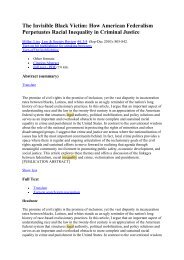Foreign Investment Strategies and Sub-national ... - E-Journal
Foreign Investment Strategies and Sub-national ... - E-Journal
Foreign Investment Strategies and Sub-national ... - E-Journal
You also want an ePaper? Increase the reach of your titles
YUMPU automatically turns print PDFs into web optimized ePapers that Google loves.
level, though informal mechanisms may also allow local institutions to influence local firms or business<br />
units. For example, Vietnamese state-owned enterprises (SOEs) fall partly under <strong>national</strong> ministries <strong>and</strong><br />
partly under local authorities.<br />
<strong>Foreign</strong> investors thus face a complex institutional environment that is continuously evolving<br />
through interaction with organizations in the host country. Figure 1 is drawn parsimoniously, showing those<br />
interactions that we consider particularly relevant, <strong>and</strong> abstracting from others, such as interaction with the<br />
inter<strong>national</strong> environment. Prospective foreign investors can observe most aspects of the formal institutions.<br />
They can, for instance, study the relevant legal texts. In contrast, informal institutions are much less<br />
transparent <strong>and</strong>, therefore, a source of uncertainty.<br />
Institutions have been included in studies of country level determinants of FDI. The empirical<br />
literature shows that investment incentives, lower tax rates <strong>and</strong> absence of performance requirements (Loree<br />
<strong>and</strong> Guisinger 1995) as well as more general market-oriented institutions attract foreign investment<br />
(Globerman <strong>and</strong> Shapiro 2003, Bevan et al. 2004). Institutions moderate transaction costs in markets in<br />
which foreign investors operate (Meyer 2001) <strong>and</strong> the importance of gaining access to local networks (Peng<br />
2003). Therefore, they may facilitate or inhibit foreign investors’ access to complementary resources.<br />
Moreover, institutions affect entry mode choice by establishing the range of permitted modes (Makino <strong>and</strong><br />
Beamish 1998) <strong>and</strong> by influencing an investor’s perceived risk (Brouthers 2002). In these ways, institutions<br />
may create barriers to FDI <strong>and</strong> lower the amount of incoming FDI. At the same time, institutions may induce<br />
foreign investors to overcome barriers, especially with respect to access to local resources, by partnering<br />
with a local firm.<br />
We focus on variations within one country <strong>and</strong> suggest that both formal <strong>and</strong> informal institutions are<br />
not homogenous. In terms of formal institutions, provinces or municipalities that have a one-stop agency to<br />
work with foreign investors <strong>and</strong> offer industrial zones with good infrastructure can greatly facilitate relations<br />
with investors. Moreover, fiscal incentives such as tax holidays or subsidies can tip the balance between two<br />
alternative sites (Oman 2000). Informal local institutions draw on distinct local traditions <strong>and</strong> cultures, <strong>and</strong><br />
may show some variation of normative values, as is the case in Vietnam (Ralston et al. 1999). This affects<br />
7














